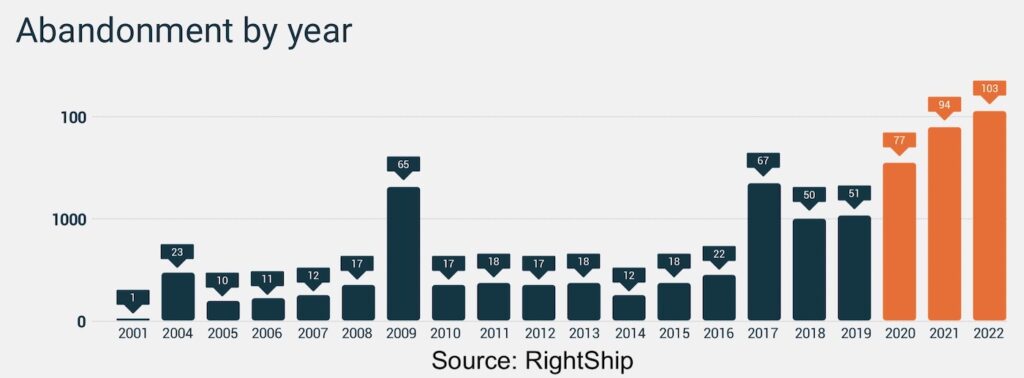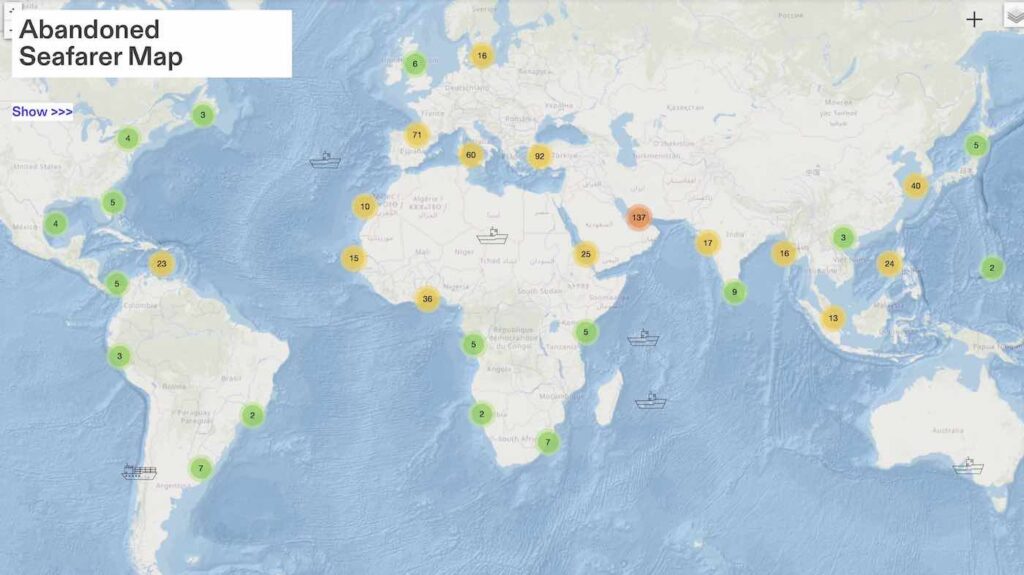You are here
Number of crew abandonment cases hits new high
Number of crew abandonment cases hits new high
Grant Rowles February 8, 2023 https://splash247.com/number-of-crew-abandonment-cases-hits-new-high/
Upwards of 1,682 seafarers coming from 103 vessels were cast adrift as 2022 became the worst year on record for reported cases of seafarer abandonment, according to RightShip.
Following five years of consistent increases, cases of abandonment have continued to soar, with the covid pandemic and conflict induced abandonment leading drivers of the uptick.
The 103 vessels and 1,682 seafarers abandoned in 2022 takes the total number of recorded abandonments over the last 20 years to 9,925.
Leading countries for abandonment in 2022 were the UAE, Spain and Turkey
The latest data collected by RightShip showing that unpaid monies to abandoned seafarers adds up to $40m.
Steen Lund, CEO of RightShip, commented: “As regulators and RightShip begin to clamp down on due diligence at all points in the supply chain, there will be catastrophic financial implications for those who partner with irreputable shipmanagers.”
RightShip already identifies vessels guilty of abandonment linked to a company in the RightShip Platform.
“We cannot and will not recommend them to our customers for voyages and we mark them unacceptable during the vetting process,” Lund said, describing seafarer abandonment as the “ruthlessness of capitalism”.
New measures to improve conditions for seafarers, including those who have been abandoned, were adopted at a meeting in December involving governments and maritime workers and employers’ organisations.
Guidelines on how to deal with seafarer abandonment have been adopted by a joint International Labour Organization (ILO)/International Maritime Organization (IMO) Tripartite Working Group.
The guidelines seek to address the significant rise in cases of abandonment of crews reported to the ILO, which have risen from less than 20 cases per year between 2011 to 2016, to 40 in 2019, 85 in 2020, 95 in 2021 and 114 cases as of mid-December 2022. The guidelines aim to improve coordination among countries, including flag states, port states, states in which seafarers are national or resident, and states in which recruitment and placement services operate, in order to resolve abandonment cases more quickly, including getting seafarers paid and repatriated home to their families.
The new guidelines draw on relevant ILO international labour standards, notably the Maritime Labour Convention, 2006 , as amended (MLC, 2006), including its most recent amendments; an earlier joint ILO-IMO resolution adopted in 2001; relevant IMO international frameworks and agreements; and relevant trends and developments in regional and national law and practice.
Under the MLC, 2006, flag states – countries where ships are registered and/or whose flag the ships are flying – must ensure a financial security system is in place for ships under those flags. The new guidelines encourage flag states to verify, at least annually, the validity of this financial security. Port states are encouraged to pay particular attention to this financial security during their inspections of foreign ships that visit their ports. States where recruitment and placement services operate are also called upon to regularly verify that those services include a system to ensure the protection of the seafarers they recruit and place.
The new guidelines set out procedures to be taken by states if a shipowner fails to fulfil their obligations to arrange and cover the cost of repatriation of seafarers, outstanding wages and other contracted entitlements, and the provision of essential needs, including medical care. In these circumstances seafarers are then considered abandoned. These procedures include developing, in cooperation with seafarers’ and shipowners’ organizations, national standard operating procedures (SOPs) to explicitly define the liabilities and obligations of the competent authority and the roles to be played by the various national stakeholders. These stakeholders include the relevant national seafarers’ welfare boards, shipping agencies, seafarers’ and shipowners’ organisations, seafarer welfare organisations, seafarer recruitment and placement services, and others.
The ILO–IMO meeting also discussed the importance of the joint ILO-IMO database relating to abandoned seafarers, and the need to update and improve it.
The Abandoned Seafarer Log, a quarterly bulletin that maps seafarer abandonment around the world, highlights the hot spots around the world with the UAE very much to the fore. The map below was compiled in November with an update due later this month.

